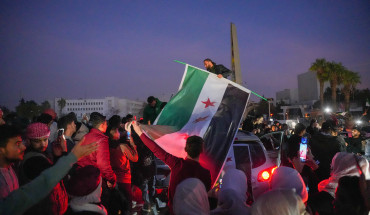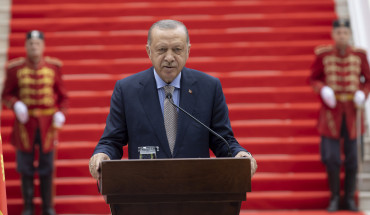On the rooftop of a three-story brick building tucked inside a dusty alley of ‘Izbat al-Nasr, a poor and informal neighborhood southeast of Cairo, Leila Hussein crouches, tending to the basil and rocket she grows. The incessant cackling of geese, chickens, and pigeons emanating from the roof of a similarly run-down, red brick structure opposite the street gives an eerie, rural soundtrack to her meticulous work.
The middle-aged woman is a pioneer in soilless rooftop gardening in her neighborhood. Every morning at dawn, she climbs the staircase to the roof, lifts the nets protecting her crops from the unwanted greediness of street rats and birds, checks the water quality, lifts the cups and checks the roots of her greens that float in water, and adds fertilizer if needed. At night, she goes back for final checks of her hydroponics tables and replaces the net, wary of further night attacks.
“When I started cultivating my roof a year ago, the neighbors were convinced I was growing drugs,” she says, laughing and pointing at the neat rows of leafy greens enclosed in individual cups on the tables. “At the time I was growing mint and arugula, so I decided to pick some samples and show them the true nature of my work during a community meeting,” she explains, smiling.
Leila's venture started a year ago, when the Participatory Development Programme (PDP) of the German Corporation for International Cooperation (known by its German acronym GIZ) identified ‘Izbat al-Nasr as a pilot to establish their new project component on climate change adaptation and upgrading in informal settlements. “We chose this location for our pilot project because it is the poorest and most vulnerable of the 9 informal neighborhoods we work in,” explained Carl-Philip Schuck, who heads the PDP’s branch dealing with climate change adaptation.
They invited 20 residents who had secure and conflict-less access to their building’s roofs to join in on this experiment. Since this technology costs about 150 Egyptian pounds per square meter (less than $20), which is prohibitive for this particularly poor community, PDP subsidized 90 percent of the infrastructure and asked the residents to cover the remaining 10 percent to ensure their sense of ownership of the project. PDP teamed up with Schaduf, a private company which develops small-, middle-, and large-scale urban agriculture systems in and around Cairo. Schaduf constructed and installed the hydroponics systems, delivered training, and today dispatches experts to help throughout the whole crop cycles and purchases the excess produce grown by the residents to sell in upscale markets in the city; the produce is labeled as local, organic, and socially beneficial. One year into the project, 15 of the neighborhood’s rooftops have sprouted with greenery. Scaling up will intensify in the coming months.
Rooftop Benefits and Food Security
The benefits of rooftop gardens in a city like Cairo, which has high levels of pollution and limited green spaces, are manifold. To begin with, replacing satellites dishes and clutter-laden roofs with horticulture reduces heat stress. Leila herself immediately noticed the difference: “We could not use the flat located right under the roof because the heat was intolerable. Now, the temperature has dropped significantly,” she says. If rooftop gardening were adopted on a large scale, the city as a whole could also benefit from the reduction of airborne carbon that is captured by plants during the photosynthesis process.
But the most significant benefit of urban agriculture is undoubtedly the food security it contributes to, and it has never been more urgent than today. Like Leila, many informal neighborhoods’ residents originate from Upper Egyptian villages and migrated to Cairo when their living conditions degraded. Because of their lack of resources, it is nearly impossible for these people to fulfill their daily dietary requirements only from the food production and markets that exist in and around the city.
Due to the prohibitive cost of fresh fruits and vegetables, Egypt’s poor rely heavily on subsidized food products like bread, oil, and sugar to get by, but the nutrition derived from these foodstuffs is not sufficient and often creates families with obese parents and malnourished children. If you add to that the rampant and uncontrolled urban encroachment that is nibbling away at the mere 3.5 percent of arable land available in Egypt, the proportions of the crisis become apparent. Additionally, with the recent spike in vegetable prices caused by severe inflation since August (prices shot up by 19.2 percent in September alone), the availability of basic and necessary foodstuffs has never been so out of reach for the most vulnerable citizens.
Small-scale poultry raising, practiced by at least 7.5 million households across Egypt, has been banned and punishable by law since 2006, after a particularly virulent and lethal strain of avian influenza A (H5N1) virus spread to humans and other animals in February of that year. “But poultry raising is a basic animal food source in Egypt, and a segment of the population has no choice but to keep practicing it, independently of the ban,” explains Dr. Markos Tibbo, livestock officer at the United Nations Food and Agriculture Organization. He explains that the influenza crisis wiped out most household-grown turkey and many geese, and that people now prefer to grow chickens, which turned out to be more resilient to the virus, as well as ducks and pigeons.
Keep it informal to make it grow?
People who practice urban agriculture in Cairo and in other Egyptian cities mostly reside in informal neighborhoods, where there is no security of tenure. “Reforming land tenure arrangements in Egypt, having better access to tenure for small-scale and peasant farmers and urban residents is absolutely critical to having stronger urban food policies,” explains Emily Mattheisen, global program officer at the Habitat International Coalition. “When we talk about rooftop gardening, if you don’t have tenure to your house there is no reality to talk about,” she adds. Since granting tenure for informal urban residents is unlikely to be on top of the government’s agenda, she thinks the best way forward for decision makers is a hands-off approach that does not disrupt the existing informal and organic urban food systems. Mattheisen explains that while it is in informal areas that there is the most capacity to create change, there is still much bureaucratic resistance to these efforts.
Dr. Ayman Abou Hadid, who currently heads the information center on climate change and renewable energy at the Agricultural Research Center, has been Egypt’s minister of agriculture on several occasions. He believes that the resistance of decision makers is mostly based on a lack of understanding of what urban agriculture is. “At the mention of rooftop gardening, Egyptians immediately think of soil agriculture and how such practices would undoubtedly affect the structure of a building,” he explains. In his view, those practices need to be promoted through training and advocacy, especially since the destruction of arable land in the Nile delta to urban encroachment is increasing. “At least we should encourage people to grow their own food,” he concluded.
The Middle East Institute (MEI) is an independent, non-partisan, non-for-profit, educational organization. It does not engage in advocacy and its scholars’ opinions are their own. MEI welcomes financial donations, but retains sole editorial control over its work and its publications reflect only the authors’ views. For a listing of MEI donors, please click here.












